3. Life of Pulsars
3.1 The discovery of a new class of pulsars
In part 1.3 we introduced the P-Pdot diagram which can be used to describe the evolution of radio pulsars. The diagram previously shown included all pulsars known in November 2003. As Figure 1 shows the situation was remarkably different before 1982, a year marking yet another important discovery in pulsar astronomy.
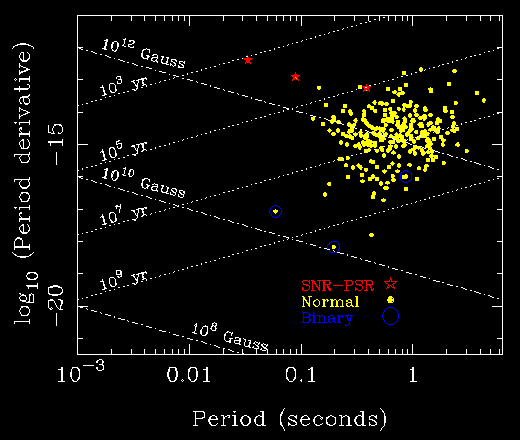 |
|
Figure 1. The P-Pdot diagrams as of 1982. this should be compared with Figure 3 of section 1 which shows the situation in 2003. |
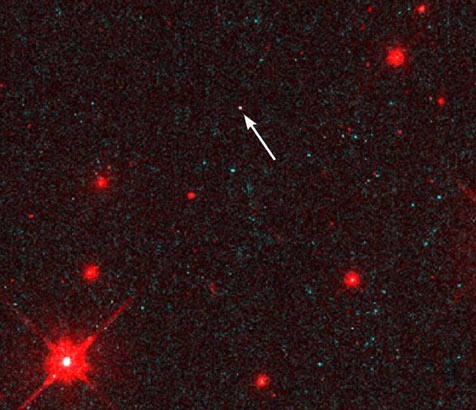
|
|
Figure 2. HST image of a dying neutron star. |
Apart from showing only a small number of pulsars, the P-Pdot diagram of 1982 shows pulsars only in the upper right part of the diagram. This reflects theories that predict the end of a pulsar's life as a radio source as soon as it had slowed down too much, preventing the radiating plasma being created above the polar cap. This was consistent with pulsars being observed with periods in the range typically 0.6 to 1.0 seconds and period derivatives (Pdots) of 10-15 seconds per second. Figure 2 shows a recent image of a lonely, dead and cooling neutron star obtained with the Hubble Space Telescope (HST).
In 1982 Don Backer from the University of California at Berkeley and colleagues studied a mysterious source which was known to exhibit highly polarised, steep spectrum radio emission. It looked just like a pulsar but no pulses had been detected. Backer and collaborators finally discovered that this source was indeed a pulsar after all, but that the pulses were emitted in such short intervals that astronomers had not been able to separate them before. In turned out that the source, now called PSR B1937+21, has a pulse period of only 1.56 millisecond! In other words, the neutron star rotates more than 38,000 times per minute!! Up to date, this is still the shortest period of any pulsar known.
The extremely short period was not the only surprising property of PSR B1937+21. The astronomers also measured that its period slow down was extremely small. Having both as small period as well as a small Pdot, the pulsar was located in a previously empty, lower left of the P-Pdot diagram. Knowing now what to look for, astronomers designed special surveys to search in particular for these "millisecond pulsars", and in the following years many more such sources have been discovered. Since 1982 the P-Pdot diagram has become much more crowded due to the tremendous success of the Parkes Multibeam survey which we will discuss in more detail later.
3.2 Recycled pulsars
Which mechanism moves pulsars into the lower left part of the P-Pdot diagram? The clue comes from the fact that with a small period and small Pdot the pulsars are also old. But even more important is the observation that the vast majority of millisecond pulsars are found to be members of binary systems.
Very soon after the discovery of PSR B1937+21 it was proposed that millisecond pulsars are previously dead pulsars which were recycled by mass transfer from a companion star. In this scenario, the progenitor to the pulsar is the more massive member of a binary system. This progenitor evolves and forms the pulsar in a supernova explosion. It is possible that the system survives this explosion. The pulsar lives its normal life and eventually dies after a few tens of millions of years. Meanwhile, the less massive companion evolves until it reaches its giant state, during which it transfers mass onto the dead pulsar. During this mass accretion, the pulsar also receives angular momentum, spinning it up to millisecond periods. Eventually the pulsar starts emitting radio emission again, and it appears in the lower left part of the P-Pdot diagram as a millisecond or "recycled pulsar". The mass dumped onto the neutron star in the recycling process, "buries" some of the pulsar magnetic field, reducing the field strength by a factor of a 1000 or so. This explains the small spin-down rate of the pulsar. This evolutionary scenario can be summarised in the P-Pdot diagram shown in Figure 3.
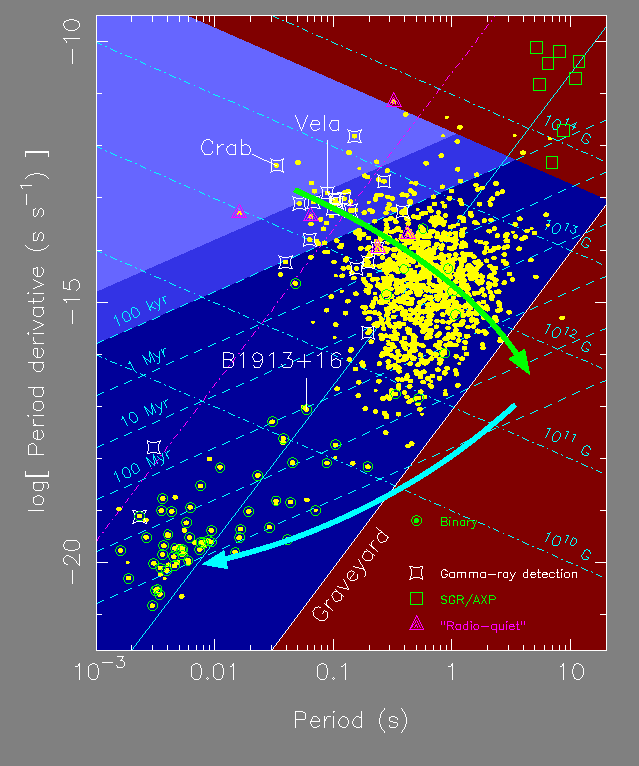
|
|
Figure 3. This P-Pdot diagram includes arrows showing the evolution of pulsars with all pulsars discovered since 1999 in the Parkes Multibeam survey as yellow dots. |
The length of the mass transfer determines the final spin period of the pulsar. If the companion is also a massive star, it evolves rather fast, limiting the accretion time until it may explode itself in a supernova explosion. In case of a less massive companion, the evolution is rather slow, allowing a long accretion time which leads to periods of only a few milliseconds. The latter process forms the common millisecond pulsar - low-mass white dwarf systems. In the massive companion case, the system usually does not survive the companion's supernova explosion and it breaks up. If it survives, however, a rare double neutron star system is formed.
3.3 The X-ray binary connection
There is direct evidence for the correctness of this model, given by the observations of X-ray binaries. X-ray binaries are, as the name indicates, luminous X-ray sources in the form of a binary system. The primary component is either a stellar black hole or a neutron star orbited by an evolved companion. Material from the companion is transferred and accumulated in an accretion disk around the main component. Eventually, some mass flows over onto the neutron star or into the black hole which releases some of the gravitational energy in the form of luminous X-ray emission. Although these bursts of X-rays do not usually happen in a periodic manner, these sources are also called (accretion driven) X-ray pulsars.
 This animation illustrates this accretion
process quite nicely [courtesy NASA].
This animation illustrates this accretion
process quite nicely [courtesy NASA].
|
Obviously, X-ray binaries which harbour a neutron star as the primary component are exactly those systems which we expect as one of the stages in the formation of a millisecond pulsar. As the relative numbers of X-ray binaries and millisecond pulsars are indeed consistent with this idea, one problem had been that X-ray pulsars did not show the expected millisecond periods. Instead, it seemed that one was usually seeing X-ray pulsars before they reach the stage of fast spinning periods. Finally, however, in 1998 Dutch astronomers discovered the first X-ray millisecond pulsar. The discovery was confirmed independently by a US team who also determined that the neutron star was in a circular binary orbit about a low massive companion. The expected but missing link had finally been discovered. Figure 4(a) shows the discovery data revealing revealing a periodicity of 400 Hz in the X-ray data whilst Figure 4(b) shows the variation of this neutron star spin frequency with orbital motion due to a Doppler shift.
|
Figure 4(a). Power spectrum of the X-ray brightness of a millisecond pulsar with a clear signal at 400 Hz. |
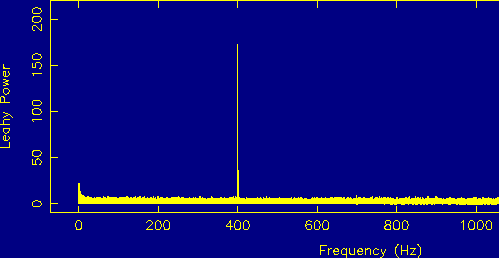
|
|
Figure 4(b). Beautiful sine wave variation in pulse arrival time caused by the pulsar orbiting its binary companion. |
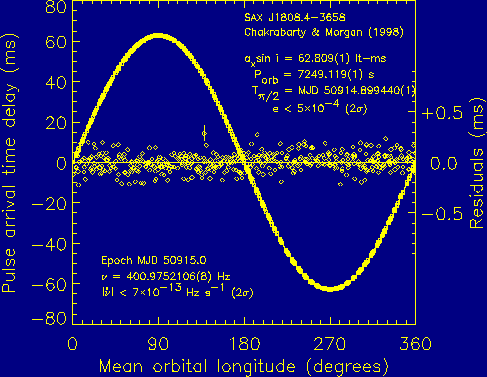
|
The formation of millisecond pulsars is summarised in the cartoon of Figure 5. The discovery of the first double pulsar in 2003 confirms this evolutionary model as we have a young pulsar in a close orbit with an old recycled pulsar - see section 5.
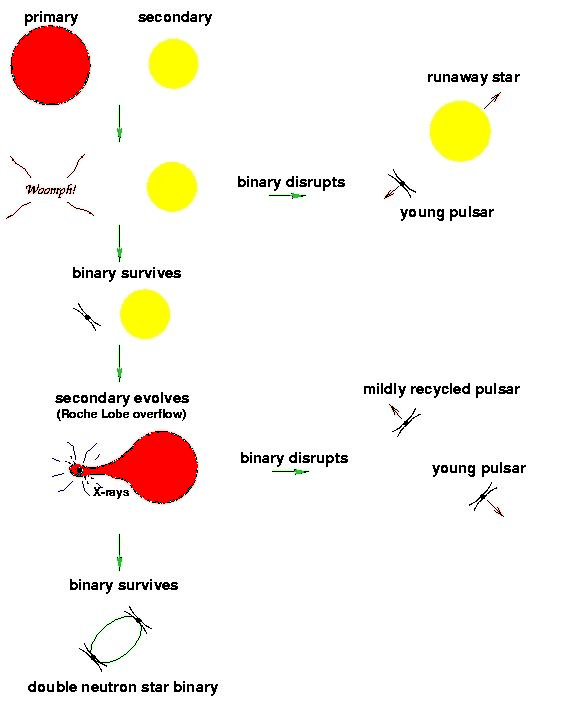
|
|
Figure 5. The formation of millisecond pulsars. |
